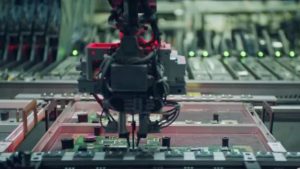 Did you recently go to the store to buy an updated phone model? Or maybe you wanted to get the latest gaming system and the shelves were empty.
Did you recently go to the store to buy an updated phone model? Or maybe you wanted to get the latest gaming system and the shelves were empty.
I recently moved to a new home, but the refrigerator or washer / dryer combo I wanted to install is backordered.
Maybe there are a lot of new cars you want?
Well, all these problems have a common cause. It’s a global tip shortage.
Semiconductor chips are small components that are essential to almost all types of modern technology devices.
Basically, it makes devices such as mobile phones, smart watches, and TVs work.
However, it is not all-purpose. All the different types of technology we use every day are made up of different components, each with its own circuit board to which these chips belong.
As new technologies are developed and more and more types of devices are introduced to the market, trillions of these chips will be needed to keep up with demand.
In fact, more than a trillion chips are manufactured each year to cover the hundreds of chips used by individuals, but the process of making them is not always simple.
“Everything is definitely automated, very sophisticated, and there are thousands of steps,” said Anandi Dutta, an assistant professor of computer science at the University of Texas at San Antonio.
Built on what is known as a silicon wafer, Dutta explains that the chips are so small that they cannot be made by hand and require a high degree of skill to make them on their own. I will.
Once assembled and tested, it was ready for distribution, but the process stopped abruptly as the coronavirus began to spread in 2020.
“When COVID-19 happened, it was thought that there wasn’t much demand for chips at that time,” Dutta said. “But what happened, we work from home, school, etc., so we needed a lot of devices, and people bought a lot of devices, workstations, gaming devices, and so on. , The opposite happened, causing supply and demand problems. “
In addition to the growing demand for electronics, it is the current collapsed geopolitical landscape we are facing that cannot solve the problem.
Since the beginning of the shortage, tensions have only risen between the world’s largest semiconductor producers and consumers.
“Now we can see that basically almost everything we use these days comes from all over the world. The final product may still be manufactured in the United States, but there are parts and parts We have suppliers, which means we have suppliers in China, India, Mexico, Europe and Australia, “said Dr. Mark Leung, Dean and Associate Professor of Management Science and Statistics at UTSA. ..
According to Leung, big companies around the world once worked together to make chips and focused on cheap labor to maximize profits.
As a result, many of our electronic components are often manufactured in multiple countries rather than in a single country.
This is a process called “globalization,” which was interrupted by the markedly increased trade war (mainly between the United States and China) and political tensions during the coronavirus pandemic.
“This is exactly what we call the” Clash of the Titans “in the movie. They will have to do all sorts of things to protect their interests. “
But that’s not the only struggle.
Natural disasters during the pandemic also contribute to the global chip shortage.
Droughts in Taiwan, factory fires in Japan, and even power grid failures in Texas in February had a direct impact on semiconductor production.
A Texas grid failure alone shut down multiple Austin plants.
“More than 70% of the world’s supply chips are destroyed. What can you do about it? There’s nothing you can do because these companies have the technology,” Leung said. Says.
From large corporations to local moms and pop shops, chip shortages affect many aspects of day-to-day operations.
Steve Flannery is the owner of Steve’s computer repair away from I-35 on the Northeast Side of San Antonio.
Flannery said he has witnessed increasing demand amid low chip supplies.
“Since COVID, we’ve noticed a significant increase in the number of people who want to repair their old laptops because of the shortage of new laptops,” says Flannery. From the customer’s pocket.
“In a normal job, repairing a computer can cost $ 200, and now it costs $ 230 to repair a computer,” explains Flanner.
In addition, Flannery said customers would have to wait longer for repairs.
“It took us about six months to ship a large number of parts, which is affecting the flow of parts. Really, we can’t repair without the right parts.”
The automobile industry was the hardest hit by this chip shortage. This is because one vehicle uses thousands of semiconductor chips for multiple electronic interfaces.
According to Deloitte’s 2019 analysis, these electronics account for more than 40% of the total vehicle cost.
Scott Hall, Executive Vice President of Operations at Swaparies, said: .com.
Hall said he has been in the automotive business for nearly 25 years and does not remember seeing such supply chain problems.
Hall said the shortage has reduced the number of new cars on the market, increasing the value of used cars and thus increasing demand.
High demand means that few used cars are available to buyers and many are looking for an alternative to buying a traditional car.
Swapalease.com, the website where Hall works, is an online marketplace for autoleasing transfers, and as the name implies, allows anyone looking for a new car to exchange autoleasing for others.
“On our website, buyers are very interested. This directly proves that some people are looking under various rocks and looking for new ways to get a car. “I’m doing it,” Hall said.
The outlook for when semiconductor chip production will return to normal is uncertain, and it is more likely that the normal version will not look the same as before.
No more countries are looking at the globalization process associated with the production of semiconductor chips.
In fact, many countries, including the United States, are currently striving for a self-sustaining production model.
It may sound like a simple solution, but it’s a difficult battle that requires a new infrastructure and a sound capital supply, and President Joe Biden is pushing for an currently stagnant infrastructure plan. I am.
“This is infrastructure,” Biden declared, raising silicon wafers while speaking at the Global Chip Shortage Virtual Summit in April at the White House.
Investing in chip production in the United States is certainly a long-term solution to chip shortages, but Mark Leung said it comes with short-term costs.
“So the question is, are you willing to pay a higher price? To rebuild your infrastructure and protect it from this kind of disruption and risk,” Leung asked. It was.
There’s not much that consumers can do until the problem is resolved, but they have to wait.
Whether you’re looking for a new car or wanting to secure your next big game console this holiday season, it may not be as easy or affordable as you might think.
Source: https://texasnewstoday.com/detailed-investigation-of-global-chip-shortage/283167/




0 Comments